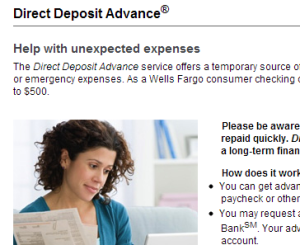Wells Fargo Called Out For Continuing To Offer Payday Loans

Wells Fargo’s “not a payday” loan
At the heart of the matter are Wells Fargo’s “Direct Deposit Advance” loans, which offer customers with certain checking accounts at the bank up to $500 in a high-interest loan in advance of the customers’ next direct deposit.
The loans have been highly criticized. Back in 2009, Tom Barlow at DailyFinance called Direct Deposit Advance “a good way to stay broke.” The bank claimed that the $2 interest on every $20 borrowed (it’s since dropped to $1.50 per $20) worked out to a 120% APR, but as Barlow points out, you only have a month to pay the loan off.
It’s worth noting that Direct Deposit Advance is not available to Wells Fargo customers in the following states and Washington, D.C.: Alabama, Connecticut, Delaware, Florida, Georgia, Maryland, Mississippi, New Jersey, New York, North Carolina, Pennsylvania, South Carolina, Tennessee, Virginia.
In a letter to the Office of the Comptroller of the Currency, which will soon be performing its examination of Wells Fargo’s CRA compliance, the Center for Responsible Lending and the National Consumer Law Center say Wells Fargo can call this loan whatever it wants, “but it is structured just like a loan from a payday loan storefront, carrying a high-cost (averaging 270% in annualized interest) combined with a short term balloon repayment (averaging just 10 days).”
The letter points out to the OCC that, per its own advisory letter about payday lending, the OCC notes that “payday loans” are “also known as ‘deferred deposit advances.’”
One of the more controversial facets of the Wells Fargo loans is how the bank collects payments. Wells will automatically deduct the debt from any direct-deposited paycheck or from any direct deposit over $200. But what if those deposits don’t come in time or are insufficient?
“If direct deposits are not sufficient to repay the loan within 35 days, the bank repays itself anyway, even if the repayment overdraws the consumer’s account, triggering more costs through overdraft fees,” reads the advocacy groups’ letter to the OCC.
The letter claims that bank-funded payday loans are not immune to the cycle of repeat borrowing and huge debt associated with storefront payday lenders.
“On average, bank payday borrowers are in debt for 175 days per year. The typical borrower takes out 16 bank payday loans within twelve months, with many borrowers taking out 20 or even 30 or more loans within one year, reads the letter. “Wells Fargo has not presented to us or others, to our knowledge, any data inconsistent with our findings– no data indicating that its payday product does not result in repeat, high-cost loans.”
The advocates cite the OCC’s payday lending guidance from 2000, which warned lenders that payday loans “can pose a variety of safety and soundness, compliance, consumer protection, and other risks to banks.”
And in 2010 testimony to Congress, the OCC declared that payday loans are “unsafe and unsound and unfair to consumers.”
Thus, argue the advocates, by continuing to offer these high-risk loans, historically associated with low-income and minority communities, Wells Fargo’s CRA rating should be negatively impacted.
The hope is that Wells will be pressured — by regulators, legislators, communities and customers — to drop Direct Deposit Advance.
Says the Center for Responsible Lending’s Kathleen Day, “One of the best things Wells could do to serve communities as the CRA requires is to stop trapping its customers in abusive payday loans.”
However, judging by the statement provided to Consumerist by the bank, it doesn’t look like Wells Fargo has any intention of doing so:
The CRA exam process consists primarily of reviewing quantitative data—lending and investments in low- and moderate-income geographies — and we are confident in our numbers…
Wells Fargo has been offering [Direct Deposit Advance] since 1994 and it has been within the scope of previous CRA exams. It is a line of credit only available to customers with established Wells Fargo consumer checking relationships and recurring qualified direct deposits. We encourage all our customers to explore other financial options, such as savings or traditional forms of credit. However, emergencies do arise, and our Direct Deposit Advance service can help customers when they are in a financial bind. Wells Fargo has policies in place to help ensure that customers do not use the Direct Deposit Advance service as a long term solution. We believe the Direct Deposit Advance service is a less expensive and more flexible alternative to a payday loan for our customers.
But the CRL’s Kathleen Day tells Consumerist that it all boils down to the fact the CRA requires banks to meet the credit needs of the community.
“Unaffordable short-term loans cause harm rather than meet needs,” explains Day. “These loans are not ‘alternatives’ to payday loans. They are payday loans. They are structured exactly the same, and like other payday loans, the data show these loans trap borrowers in a long-term cycle of high-cost, unaffordable debt.”
Want more consumer news? Visit our parent organization, Consumer Reports, for the latest on scams, recalls, and other consumer issues.

